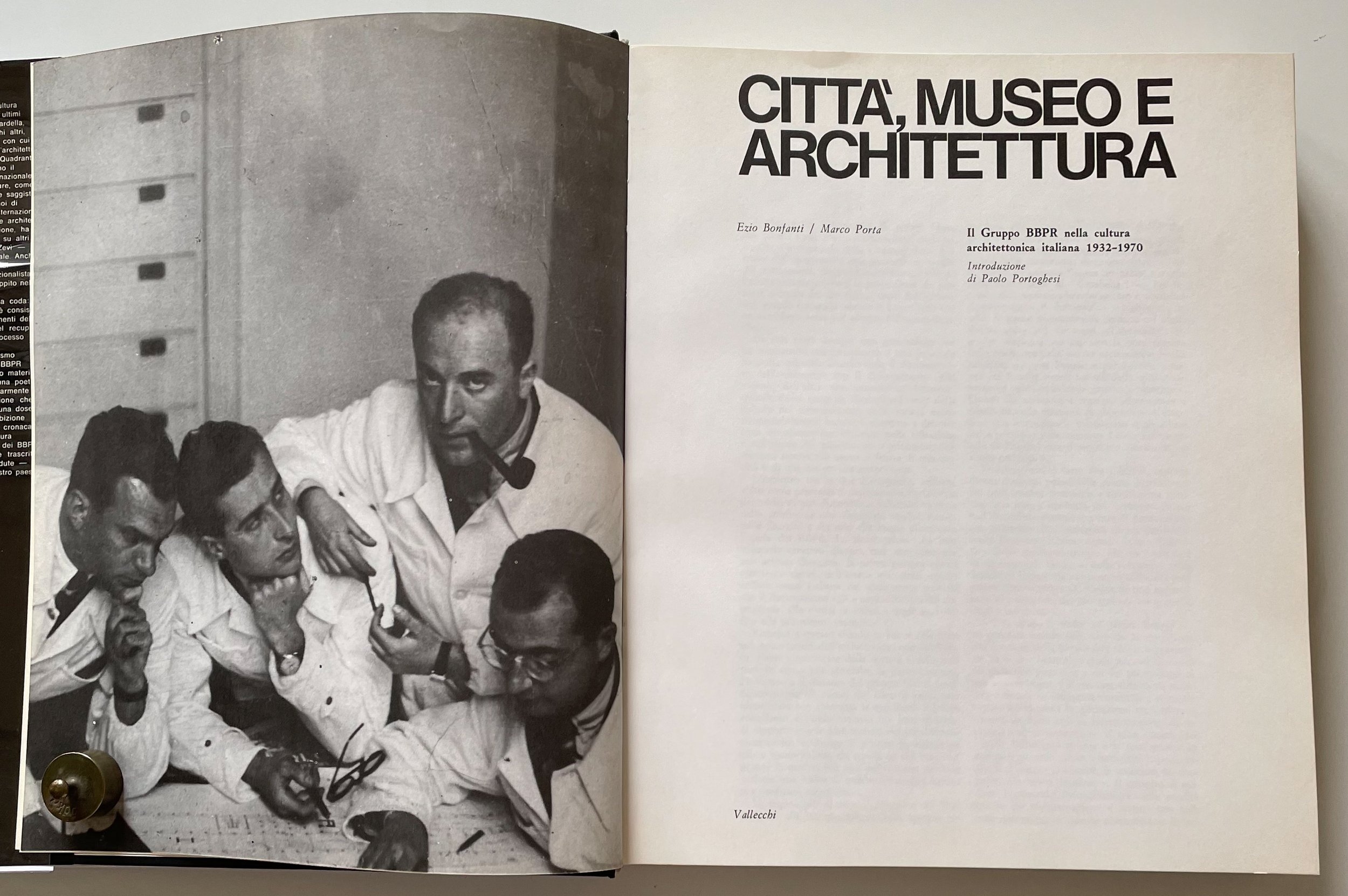 Image 1 of 7
Image 1 of 7

 Image 2 of 7
Image 2 of 7

 Image 3 of 7
Image 3 of 7

 Image 4 of 7
Image 4 of 7

 Image 5 of 7
Image 5 of 7

 Image 6 of 7
Image 6 of 7

 Image 7 of 7
Image 7 of 7








[1ST ED] Citta', Museo e Architettura: Il Gruppo BBPR nella cultura architettonica italiana 1932-1970
Monograph (and catalog raisonne through 1970) on Gruppo BBPR, the Italian architecture and design firm founded in 1932 in Milan by Gianluigi Banfi, Lodovico Barbiano di Belgiojoso, Enrico Peressutti, and Ernesto Nathan Rogers. Published by Vallecchi in 1973 with text in Italian by Ezio Bonfanti and Marco Porta and an introduction by Italian architect Paolo Portoghesi. Gruppo BBPR began its work steeped in Italian Rationalism, disbanded in 1938 as a result of taking anti-fascist positions, and re-formed after the war less Banfi who perished in the Mauthausen concentration camp. Their post-war oeuvre featured Brutalist structures such as the Valasca Tower of 1958, along with two important projects for Olivett: the New York City showroom of 1954 and a building in Barcelona completed in 1964. Unlike their more avant-garde counterparts, BBPR straddled traditional and modernist impulses, with a philosophy based on historical continuity—“respect [for] the pre-existing environment” in Rogers’s formulation—a controversial position vis-a-vis International Style modernism. In addition to architecture and exhibition design, they produced a range of product designs, including furniture lines for Olivetti and Arflex, and lighting designs for Artemide and Arteluce. First edition, thick oversized 4to, hardcover with pictorial dust jacket, 400 pages of which 233 are text and 177 comprise a chronologically organized appendix. Fully illustrated in black-and-white. Small chip to bottom of front hinge. Light rubbing and chipping to price-clipped dj, with small open tears at corners.
Monograph (and catalog raisonne through 1970) on Gruppo BBPR, the Italian architecture and design firm founded in 1932 in Milan by Gianluigi Banfi, Lodovico Barbiano di Belgiojoso, Enrico Peressutti, and Ernesto Nathan Rogers. Published by Vallecchi in 1973 with text in Italian by Ezio Bonfanti and Marco Porta and an introduction by Italian architect Paolo Portoghesi. Gruppo BBPR began its work steeped in Italian Rationalism, disbanded in 1938 as a result of taking anti-fascist positions, and re-formed after the war less Banfi who perished in the Mauthausen concentration camp. Their post-war oeuvre featured Brutalist structures such as the Valasca Tower of 1958, along with two important projects for Olivett: the New York City showroom of 1954 and a building in Barcelona completed in 1964. Unlike their more avant-garde counterparts, BBPR straddled traditional and modernist impulses, with a philosophy based on historical continuity—“respect [for] the pre-existing environment” in Rogers’s formulation—a controversial position vis-a-vis International Style modernism. In addition to architecture and exhibition design, they produced a range of product designs, including furniture lines for Olivetti and Arflex, and lighting designs for Artemide and Arteluce. First edition, thick oversized 4to, hardcover with pictorial dust jacket, 400 pages of which 233 are text and 177 comprise a chronologically organized appendix. Fully illustrated in black-and-white. Small chip to bottom of front hinge. Light rubbing and chipping to price-clipped dj, with small open tears at corners.
Monograph (and catalog raisonne through 1970) on Gruppo BBPR, the Italian architecture and design firm founded in 1932 in Milan by Gianluigi Banfi, Lodovico Barbiano di Belgiojoso, Enrico Peressutti, and Ernesto Nathan Rogers. Published by Vallecchi in 1973 with text in Italian by Ezio Bonfanti and Marco Porta and an introduction by Italian architect Paolo Portoghesi. Gruppo BBPR began its work steeped in Italian Rationalism, disbanded in 1938 as a result of taking anti-fascist positions, and re-formed after the war less Banfi who perished in the Mauthausen concentration camp. Their post-war oeuvre featured Brutalist structures such as the Valasca Tower of 1958, along with two important projects for Olivett: the New York City showroom of 1954 and a building in Barcelona completed in 1964. Unlike their more avant-garde counterparts, BBPR straddled traditional and modernist impulses, with a philosophy based on historical continuity—“respect [for] the pre-existing environment” in Rogers’s formulation—a controversial position vis-a-vis International Style modernism. In addition to architecture and exhibition design, they produced a range of product designs, including furniture lines for Olivetti and Arflex, and lighting designs for Artemide and Arteluce. First edition, thick oversized 4to, hardcover with pictorial dust jacket, 400 pages of which 233 are text and 177 comprise a chronologically organized appendix. Fully illustrated in black-and-white. Small chip to bottom of front hinge. Light rubbing and chipping to price-clipped dj, with small open tears at corners.








